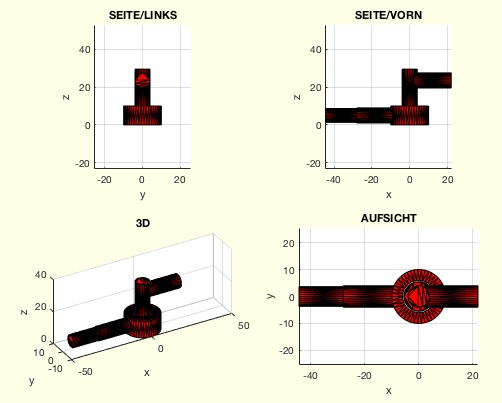VTget
by Tim C. Lueth, SG-Lib Toolbox: SolidGeometry 5.6 - NDI Camera
Introduced first in SolidGeometry 1.0, Creation date: 2010-09-01, Last change: 2025-09-14
returns immediately the Matrix of a registered Tracker by the NDI camera
See Also: Vreset
, Vstray
, Vstat
, VTset
, VTgetp
, VTlearn
, VTget2
, VTget2p
Example Illustration

Syntax
[T,t,rms]=VTget(nr)
Input Parameter
nr: | | is the number of the requested Tracker |
Output Parameter
T: | | is the HT matrix of the requested tracker nr. |
t: | | is the exact system time when the matrix was recorded |
rms: | | is the RMS of the spheres with respect to the stored geometry |
Copyright 2010-2025 Tim C. Lueth. All rights reserved. The code is the property of Tim C. Lueth and may not be redistributed or modified without explicit written permission. This software may be used free of charge for academic research and teaching purposes only. Commercial use, redistribution, modification, or reverse engineering is strictly prohibited. Access to source code is restricted and granted only under specific agreements. For licensing inquiries or commercial use, please contact: Tim C. Lueth
Algorithm (Workflow)
This function, VTget, is designed to retrieve transformation data and timestamps from a tracking system. It is part of a library that interfaces with a tracking device, likely used in applications such as motion capture or navigation systems.
Input Parameter
- nr: This is the number of the tracker to request data from. It is an integer value ranging from 1 to 6, indicating which tracker in a multi-tracker system the user wants to query.
Output Results
- T: This is the homogeneous transformation matrix. It represents the transformation data, which typically includes rotation and translation information of the tracked object in space.
- rms: This is the root mean square error value. It provides a measure of the accuracy or quality of the transformation data.
- tcam: This is the timestamp indicating when the transformation data was captured by the camera. It is measured in seconds using the camera's internal clock.
- tpc: This is the timestamp indicating when the data was requested from the camera. It is measured in seconds using the PC's internal clock.
Algorithm Steps
- The function begins by checking if the global variable
vicra_global is initialized. This variable is expected to hold the interface to the tracking system.
- If
vicra_global is empty, the function throws an error, indicating that the Vicra driver is not initialized and suggesting the user call VTReset first.
- If
vicra_global is initialized, the function calls the method vtget on vicra_global, passing the tracker number nr as an argument.
- The method
vtget returns four values: the transformation matrix T, the RMS error rms, the camera timestamp tcam, and the PC timestamp tpc.
- These values are then returned by the function to the caller.
Algorithm explaination created using ChatGPT on 2025-08-19 00:53. (Please note: No guarantee for the correctness of this explanation)
Last html export of this page out of FM database by TL: 2025-09-21